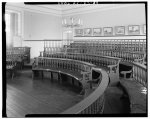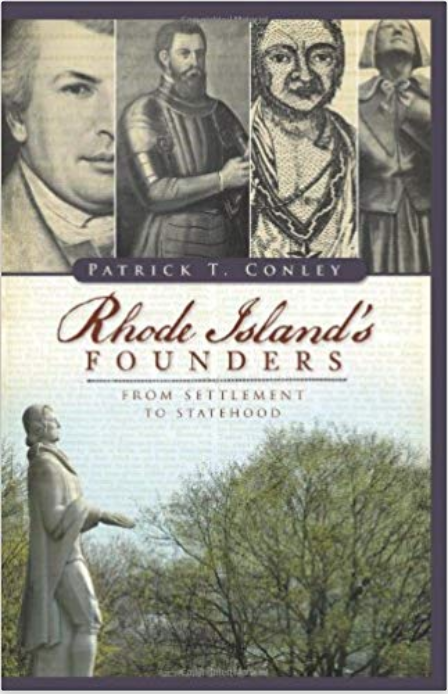From 1974 to mid-1977 when I served as volunteer chairman of the Rhode Island commission to celebrate American independence (ri 76) one thorny issue involved the correction of the long-held belief that Rhode Island declared its independence from England on May 4, 1776. Glen LaFantasie, my director of publications, refuted this hyperbolic claim in a scholarly essay entitled “An Act for All Reasons—Revolutionary Politics and May 4, 1776,” published in May, 1976 in Rhode Island History. Unfortunately some myths don’t die or even fade away.
Another bicentennial falsehood—one that generated media attention—was the claim by crusty state senator and history teacher Erich O’D. Taylor of Newport that the bold act of May 4, 1776 occurred in his city by-the-sea rather than in Providence, where a plaque commemorating the so-called “act of independence” had been affixed to the wall of the legislative chamber in the Old State House on May 4, 1913 by the Daughters of the American Revolution. Ultimately Taylor’s persistent but unfounded claim was dismissed.
A third-of-a-century later, while serving as the consulting editor of the three Rhode Island volumes of Professor John Kaminski’s massive thirty-two volume series entitled, The Documentary History of the Ratification of the Constitution, I had the pleasure of reviewing the detailed research performed by John and his staff, not only on the 1787-1790 period but also on the entire Revolutionary era in Rhode Island. Kaminski’s research pinpointed the exact date of Rhode Island’s act of independence, namely July 19, 1776 when the assistants in the state Senate (i.e., state senators) ratified the Declaration of Independence that had emanated from Philadelphia two weeks earlier. The members of the House of Deputies (i.e., representatives) had endorsed the document on the previous day. In light of this finding and my editorial verification thereof, I published an abridged version of the following essay in the Providence Journal on July 19, 2012.
Rhode Island’s ratification of the Declaration of Independence involves a very little-known and embarrassing irony—Metcalf Bowler, the Speaker of the House, presided over the vote in the lower chamber. Historian Christian M. McBurney in his recent book, Spies in Revolutionary Rhode Island (The History Press, 2014), documents the fact that Bowler later spied for England. McBurney describes the traitorous Bowler as “the Benedict Arnold of Rhode Island.” That appellation is also ironic. General Benedict Arnold was a man with Rhode Island antecedents as the great-grandson and namesake of our first governor. That man, the first Benedict Arnold, was actually designated by name as our chief executive in Rhode Island’s Royal Charter of 1663.
On the morning of May 4, 1884 James S. Slater of Slatersville, a descendant of Samuel and John Slater, hung a U.S. flag from the porch of his house and announced that he considered that day a holiday–Rhode Island Independence Day.
Twenty-four years later he had convinced nearly everyone including the General Assembly and several state historians (namely, Irving B. Richman and Clarence Brigham) that he was correct. On May 26, 1908 the legislature declared that henceforth May 4 was to be known as Rhode Island Independence Day but should “no wise be construed a holiday.” This Republican dominated body, subsidized by mill owners, was not sufficiently patriotic to give their workers a day off. Not until the pro-labor New Deal Democrats gained control by 1936 did the day gain holiday status.
Sidney S. Rider, Rhode Island’s leading scholarly constitutional historian, uttered a futile disclaimer in 1908 and again in 1913 when the Daughters of the American Revolution placed a plaque on the interior wall of Providence’s Old State House calling the May 4 measure “The Act Constituting Rhode Island the First Free and Independent Republic in America and Asserting Her Absolute Independence of England, Two Months Before the Declaration of Independence in America.”
By May 4, 1776 three other colonies had made defiant moves: (1) South Carolina on March 26 adopted its own constitution replacing her proprietary charter–but it remained a colony; (2) North Carolina on April 12 unanimously empowered her delegates to the Second Continental Congress to “concur with the delegates of other colonies in declaring independency; and (3) Massachusetts on May 1 enacted a resolution that replaced the name “King of Great Britain” with the name of the “Government and People of the Massachusetts Bay, in New England,” on all civil writs and commissions. This resolution anticipated Rhode Island’s more defiant, permanent, and enforceable law three days later.
Since 1909 we have observed May 4th as Rhode Island Independence Day, as a result of the relentless twenty-five year campaign by Smithfield town clerk James S. Slater to obtain that designation. The declaratory statute passed on May 26, 1908 required the governor to order “a salute of thirteen guns to be fired at 12 o’clock noon ”every May 4th” and directed the state’s commissioner of public schools to conduct a program of “patriotic exercises” annually to honor “that act declaring it [Rhode Island] sovereign and independent.” In 1936, May 4th was raised to the status of an official state holiday, but one on which work could be performed. Now comes a grumpy, bookwormish, old historian (me) to tell you that we have been celebrating on the wrong day. Unlike King George III, I do not wish to reign on anyone’s celebratory parade. However, I am not averse to confusing you with the historical facts.
Back in 1976 when I served as volunteer chairman of the Rhode Island Bicentennial Commission (ri76), a state senator from Newport insisted that we hold the May 4th commemoration in Newport’s Colony House, wrongly alleging that the vote of defiance had occurred there. My commission staff and I not only disproved that assertion, we also uncovered the fact that the six Newport deputies voted against the measure. Needless to say we conducted our festivities in Providence’s Old State House on Benefit Street. At that time we also tried to correct the historical imprecision with regard to “independence and “sovereignty,” but myths are resistant to facts and reason.

Interior of the Old Colony House in Newport, where the May 4, 1776 Royal Renunciation did not occur, despite previous commemorations to the contrary (circa 1935, Library of Congress)
To our embarrassment, on May 4, 1913 the Daughters of the American Revolution had accepted Slater’s analysis and placed a plaque in the Assembly Room of the Old State House (where the ri76 Commission held is meetings) declaring that “in this room” the House of Deputies “passed the act constituting Rhode Island the first free and independent in America and asserting her absolute independence of England.” Myths are even more resistant to truth when they are inscribed on bronze plaques!
Nearly all people, even trained historians, repeat the assertion that “Rhode Island was the first colony to declare independence from England, doing so on May 4, 1776, exactly two months before the Second Continental Congress approved the Declaration of Independence.” It is good to be first, just as it is good to be King! And Rhode Island was indeed the first to renounce allegiance to King George III. That is what happened in Providence on May 4, 1776 via a unanimous vote in our House of Magistrates (i.e., the Senate), and an overwhelming vote in the House of Deputies (i.e., the House of Representatives) with only the six-man delegation from vulnerable Newport in dissent. However, the audacious act ditching a specific and allegedly tyrannical king did not renounce Parliament and clearly affirmed our continued status as an English colony.
On May 4, 1776 Rhode Island made a courageous and defiant move that kept this colony in the vanguard of resistance to imperial policies. Though it is worthy of commemoration, it was not a declaration of independence from the British empire. May 4th, therefore, is really Rhode Island Royal Renunciation Day. For those of you who like alliteration, this sounds great; for those of you who prefer myth, hyperbole, or custom, this sounds grating.
The same day on which they ousted the king, our intrepid legislators instructed Rhode Island’s two-man delegation to the Second Continental Congress—Stephen Hopkins and William Ellery—to work for the establishment of a union and to fight to preserve liberty.
Enthusiastically following such instructions, Hopkins and Ellery voted for the Declaration of Independence on the Fourth of July 1776 and became two of the eventual fifty-six signers of that document. The “General Congress,” as it was called, sent the Declaration to the thirteen colonies for approval. On July 18th, exactly two weeks later, the Rhode Island General Assembly convened in Newport to ratify this bold proclamation. It is probable that the members of the lower house (the deputies) voted their approval on July 18, but the manuscript journal of that body has not survived, preventing us from confirming that supposition. Because the legislature convened on July 18, that date has been used as our real independence day by knowledgeable historians from John Russell Bartlett onward, myself included. Bartlett’s published edition of Rhode Island’s early records gives the impression that the ratification process was completed on July 18th.
Recently, however, the Center for the Study of the American Constitution, headed by my colleague Dr. John Kaminski, has discovered entries in the House of Magistrates journal indicating that the upper house adjourned to July 19th before giving its assent to independence. On that fateful day, this chamber, which then included Governor Nicholas Cooke of Providence and Lieutenant Governor William Bradford of Bristol as voting members, completed the approval process. Their handwritten journal reads as follows: “Vote of the Lower House approving the Resolution of the General Congress declaring the United Colonies free and independent states was read and concurred. On July 20, after vowing that “we will support the said General Congress with our Lives and Fortunes,” the legislators altered Rhode Island’s official name by requiring that henceforth the “Title of this Government, in all Acts and Instruments, whether of a public or private nature, shall be the State of Rhode Island and Providence Plantations.” From May 4, 1776, to that point Rhode Island had continued to designate itself as an “English colony.”
Independence came with a vengeance. On Sunday July 21, the General Assembly passed “an act to punish persons who shall acknowledge the King of Great-Britain to be their Sovereign.” Those who did so would be “deemed guilty of a high misdemeanor,” fined one hundred pounds, pay all costs of prosecution, and be jailed until the fine was satisfied. Renunciation had become denunciation.
If the time ever comes to create another state holiday to give workers a respite from the hot and humid days of summer, perhaps our General Assembly will select July 19th in commemoration of its most momentous achievement—the establishment of Rhode Island as an independent state.
[Banner Image: Stephen Hopkins, one of the two signers of the Declaration of Independence for Rhode Island (Brown University Portrait Collection)]
























